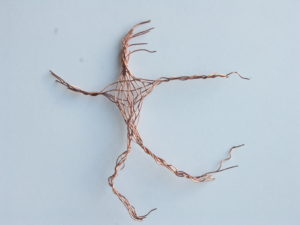I am a dyspraxic Clinical Psychologist with ADHD, turned artist. I also teach Mindfulness Meditation and I am a Soul Motion Conscious Dance facilitator. My work is strongly influenced by neuroscience (click here to read more), trauma, ancestry and deep ecology: it is an intimate reflection of my personal journey: making meaning of challenging experiences, honouring my heart and soul, have guided me to the richness of creative expression.
Following a personal health crisis of breast cancer and the loss of my oldest friend to it, the welcome return to creativity has been a homecoming. I believe that the importance of creativity, joy, beauty and rapture are deep human needs. Art can express what it means to be human in this world: there is no ‘quick-fix’ to a fulfilling life and the focus required in the making of it can bring much-treasured peace. It is my deep wish that others can experience and cultivate connection to themselves and to others through creativity.
Another key inspiration is the natural world, and my deep appreciation of plant and animal worlds: the order, structure, colours and cycles of creatures and the cosmos. I am deeply grateful that the natural world is on my doorstep, on the River Dart, in Devon.
Connecting with the threads of our weaving ancestors offers a heartfelt continuity with the social history and lives of women throughout the ages. On a personal level, I deeply value how weaving connects me with my grandparents, Letitia and Charles, who ran a tailoring and weaving business in Ireland.
Themes of my work
‘T hreads catching light’ is a theme of my work. For me, it symbolizes the gold which emerges from those wounded places in ourselves when they are ‘broken open.’ An intention of my current work is to speak to the beauty that can blossom from within us when we can tenderly embrace those wounds. I am touched by how the Japanese art of Kintsugi gives expression to this concept in the form of gold and precious metals used to repair broken ceramics: the beauty of the gold in the break enhances the overall beauty. Of course, embracing our human frailty also means finding a way of being with our imperfections, even celebrating them, and so I make space for wabi sabi, the honouring of impermanence and imperfection, which of course is part of our humanity.
hreads catching light’ is a theme of my work. For me, it symbolizes the gold which emerges from those wounded places in ourselves when they are ‘broken open.’ An intention of my current work is to speak to the beauty that can blossom from within us when we can tenderly embrace those wounds. I am touched by how the Japanese art of Kintsugi gives expression to this concept in the form of gold and precious metals used to repair broken ceramics: the beauty of the gold in the break enhances the overall beauty. Of course, embracing our human frailty also means finding a way of being with our imperfections, even celebrating them, and so I make space for wabi sabi, the honouring of impermanence and imperfection, which of course is part of our humanity.
